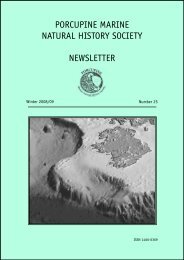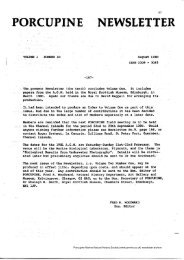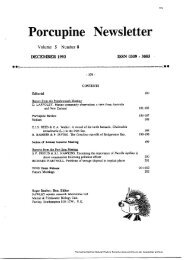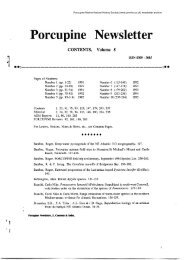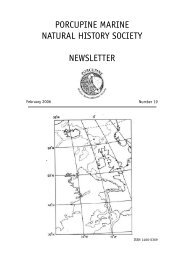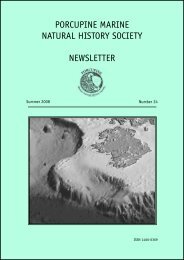Porcupine Newsletter - No. 16 November 2004 - Porcupine Marine ...
Porcupine Newsletter - No. 16 November 2004 - Porcupine Marine ...
Porcupine Newsletter - No. 16 November 2004 - Porcupine Marine ...
Create successful ePaper yourself
Turn your PDF publications into a flip-book with our unique Google optimized e-Paper software.
32Osilinus lineatus and other intertidal Mollusca near rangelimits in the north of IrelandJ.D. NunnCherry Cottage, 11Ballyhaft Road, Newtownards, Co. Down BT22 2AWIntroductionDuring the late 18th and early 19th century, very little work was done on the marine fauna ofthe north of Ireland. The lack of records was to some extent remedied in the mid 19 th century by aunique group, the Belfast Dredging Committee. Two of its members, George Hyndman (1796-1867)and William Thompson (1805-1852) were active in exploring the marine life off the coasts of Downand Antrim by dredging. Other important naturalists were also members, e.g. George Dickie (1812-1882), the first Professor of Natural History at Queen’s University, Belfast, and Charles Wyville-Thomson (1830-1882). Many of their results were published in the Reports of the British Association(1857-1859). Dickie (1858) produced the first paper on a distinct geographical area, whichappropriately was Strangford Lough. However, all the active workers had died by 1882, and littlework was done in subsequent years. Counties Donegal and Londonderry were almost completelyignored by early workers, with the exception of Hart (e.g. Hart, 1892) and Praeger (e.g. Praeger,1894). All records for the north of Ireland were summarised by Praeger in 1889, whilst Nicholssummarised all records for Ireland in 1900 – still the most recent ch ecklist of Mollusca for Ireland.For most of the early 20 th century, there was little recording of marine Mollusca in the north ofIreland, with the exception of <strong>No</strong>ra Fisher-McMillan (1908-2003). She actively recorded in Antrimand elsewhere, and produced a series of short papers mainly between 1926 and 1952 (e.g. Fisher,1937). In 1945, Queen’s University purchased a house in Portaferry, Co. Down, which became the<strong>Marine</strong> Biology Station. For about 10 years, many sites in Strangford Lough were investigated, andall these records, together with the earlier ones, were published by Williams (1954) in an annotatedchecklist. Although the 1960’s and 1970’s saw an expansion of Queen’s University activity in marinebiology, very little of the published work during this period concerned the biogeography of Mollusca;although a copy of Williams’ paper kept in the <strong>Marine</strong> Station was annotated by hand with anyinteresting observations. The most recent specific survey of Strangford Lough for marine Molluscawas carried out by Nunn in 1989-1992 for a M.Sc. Thesis, published as a paper in 1994 (Nunn,1994).In the mid 1980’s, the intertidal molluscan fauna of <strong>No</strong>rthern Ireland was surveyed by Heriot-Watt University (Wilkinson et al., 1988) as the <strong>No</strong>rthern Ireland Littoral Survey, commissioned bythe D.0.E. (NI). In 1986, the north coast of Ireland was surveyed for Mollusca by the author andShelagh Smith (Nunn & Smith, 1987). A detailed study was also made of the Mulroy Bay area (northDonegal) (Nunn, 1996). Subsequent intertidal records for the north of Ireland have been sparse,mainly casual observations by the author, and some intertidal records from the BioMar survey inDonegal (Picton & Costello, 1998).A project was initiated in 1992 by the author, in collaboration with Shelagh Smith, BernardPicton and Dave McGrath, to map the marine Mollusca of Ireland. The results of that project will bepublished as a CD (Table 1). This project provided a further stimulus to recording in the north ofIreland.32Table 1 Details of CD projectTitle: The marine Mollusca of Ireland: checklist, atlas and bibliographyAuthors: Julia Nunn, Shelagh Smith, Bernard Picton & Dave McGrathPublication date: [<strong>No</strong> idea! But hopefully before the end of this century…….]Format: CD-ROM with accompanying instructions and notes as a sleeveContent: historical background; text & distribution map for each species; photographs for 200+species; photographs for marine rocky biotopes in Ireland; ecology & description of biotopes whererelevant to Mollusca; etc.PMNHS <strong>Newsletter</strong> <strong>No</strong>.<strong>16</strong> <strong>No</strong>v <strong>2004</strong><strong>Porcupine</strong> <strong>Marine</strong> Natural History Society (www.pmnhs.co.uk) newsletter archive



